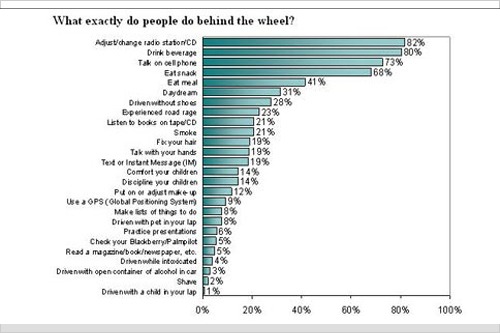
Mark Stevens is a multitasking maniac. A couple of months ago, the White Plains, New York, marketing consultant was working his cell phone with one hand and his Blackberry with the other while trying to steer his Mercedes SL500 with his wrists and knees — when he plowed it into a rental vehicle in an Enterprise parking lot. That followed his fourth ticket in four years for talking on his cell phone while driving.
"If you are a determined multitasker, it's an addiction — and you can't stop it," said the 59-year-old Stevens.
Talk about distracted driving. Even during a short trek, he said, he's likely to sip a Diet Coke and a bottled water, eat a sandwich, read a copy of The Economist, write notes to himself and listen to NPR, in addition to performing his cell phone and Blackberry action — oh, and driving. "I'm a driven person, and that's why I do all this stuff while I drive." Efficiency, not safe driving, is primary.
Although he may represent an extreme, there's a little bit of Stevens in many of us. Multitasking while driving has become endemic — and epidemic — on American roads. More drivers are trying to figure out what other duties they can perform while driving. Insurance companies, meanwhile, are trying to make drivers keep their eyes on the road and their hands on the wheel. And automakers are caught between consumer demands for more capabilities and conveniences — and the safety and legal concerns that often compel vehicle designers to make multitasking more difficult.
The growing number of cultural references to multitasking resonates with all of us. They include the TV ad depicting a group of business colleagues moving all their office functions into a car and the Allstate Insurance commercial in which spokesman Dennis Haysbert tsk-tsks viewers about multitasking.
The reasons for multitasking are many. Ever-longer commutes are tempting time-starved Americans to invent ways to spread more tasks over the hours they must spend in their vehicles. Also blame cell phones, video entertainment systems and iPods. Throw in the fact that many drivers apparently don't care that they might be annoying — or even alarming — other drivers by applying mascara, drinking hot coffee, reading a pulp novel or selecting station XM 132 all at the same time.
A recent survey by Nationwide Insurance quantified some of the trend's scary dimensions. More than 80 percent of drivers surveyed identified themselves as multitaskers. Sixty-eight percent eat while driving; texting or instant-messaging while driving, or fixing hair, is practiced by 19 percent of drivers; 14 percent comfort or discipline children while behind the wheel; and 8 percent drive with a pet in their laps.

Weather conditions had little effect on drivers' tendency to multitask. Even those who perceive themselves as safe drivers admitted doing outlandish things behind the wheel, including changing clothes, balancing a checkbook and shaving.
And multitasking is going to increase before it wanes. About 35 percent of Gen Y-ers say they always multitask, compared with 30 percent of Gen X-ers and just 21 percent of baby boomers. Those differences are amplified in important behaviors such as fiddling with a cell phone while driving: 37 percent of Gen Y-ers admit doing it versus just 17 percent of Gen X-ers and only 2 percent of boomers. About 89 percent of teenagers reported seeing other teens on their cell phones at least sometimes while driving, reports a recent State Farm Insurance survey.
The problem for drivers and insurance companies is that drivers are just bad at multitasking successfully. About 80 percent of all crashes are related to some form of distracted driving, according to the U.S. government.
"Driver behavior is only getting worse," said Bill Windsor, associate vice president of safety for Columbus-based Nationwide Insurance. "Car design and safety features have helped reduce fatalities over the last 10 years, but there are signs — such as an increase in fatalities among pedestrians and motorcyclists — that problems with driving behavior are starting to outstrip vehicle and roadway improvements."
Governments, insurance companies and other players can mitigate the problem to some extent. Four states and the District of Columbia already outlaw the use of handheld phones while driving, and at least 38 states currently are debating bills that would specifically regulate text messaging while behind the wheel, according to the National Conference of State Legislatures. Highway designers are trying to add more rumble strips on highway shoulders to startle those who've strayed to the side, and creating greater numbers of safe rest spots along the nation's roads.
But a large part of the responsibility and opportunity for dealing with multitasking rests with automakers themselves. The scope of their dilemma is perfectly underscored by the fact that an alliance of General Motors, Toyota, Nissan and Ford spent $6 million over the last four years to study driver distraction and develop solutions. Their conclusion was that drivers can safely withstand just about any amount of aural distraction in a vehicle as long as they keep their vision on the road in front of them.
"It was a lot of expensive research just to validate the idea that you should keep your eyes on the road," admits Rich Deering, GM's senior manager of crash-avoidance system development. "But this is an issue that won't go away."
The auto industry is pulled in two directions. As quality and other differences among vehicle brands have dwindled over the last generation, car companies have turned to comfort and convenience features in their battle for market share. In the process, they have converted many of their vehicles into rolling living rooms and offices. Passengers are invited to watch movies, thanks to rear-seat entertainment systems; work on their laptops, courtesy of ample power outlets (including 110-volt connections) throughout the vehicle; and use OnStar to tap into sports scores and stock-price quotes on the Internet.
Vehicle designers even encourage drivers to engage in more multitasking by, for example, increasing the capabilities of audio systems, providing devices and slots to facilitate mobile-phone usage, and cramming every square inch around the driver with drink holders, trays and even laptop compartments.
It's hard to keep drivers away from all those distracting goodies that, nominally at least, are meant only for passengers to enjoy.
"We need to provide reasonable accommodations for a wide variety of activities that people want to do in their cars," said Andrew Coetzee, vice president of product planning for Toyota Motor Sales, USA. "We do have responsibilities to meet the needs of customers. It's up to customers to use them at their discretion."
Yet automakers have taken measures to limit multitasking by drivers — or at least make it safer — in specific areas:
Navigation systems
The industry's unspoken agreement bans navigation screens that require drivers to lower their heads more than 30 degrees from a straight-ahead position. Also, many automakers won't allow front-seat occupants to enter destination addresses manually while the vehicle is in motion.
Meanwhile, they're all working on improving voice-recognition technology so drivers won't have to touch navigation screens at all. Based on several years of experience with its OnStar system — which relies on a customer-service person to give drivers oral directions — GM is convinced that voice interaction largely takes the danger out of navigation systems. "We're just not seeing a crash problem there because, with OnStar, drivers can keep their eyes on the road," Deering said.
Bluetooth
Despite some states' laws to the contrary, drivers aren't going to stop using cell phones while driving. So automakers are doing their best to make it as safe as possible. Installing hands-free technologies such as Bluetooth across their entire lineups is a major focus. "There's a social responsibility we feel in developing a system like that," said Coetzee. "It's taking a more reasonable approach than just saying, 'Don't use a cell phone when you drive.'"
Audio systems
Automakers are pushing to integrate vehicle sound systems on digital platforms and to create easy interfaces with MP3 players so there is a central, convenient source of control on the dash — instead of the makeshift assemblages of iPod cradles, extenders, power-port plug-ins and other devices that many drivers now use. Most vehicles already are available with steering-wheel-mounted audio controls.
Fold-down front seats
Many vehicles now offer fold-down front passenger seats with flat backs that drivers can use as makeshift desks, as well as110-volt power ports to power their laptops.
Food and beverage handling
This is an area that exemplifies how automakers can enhance the multitasking experience without making it more distracting or dangerous — the ultimate win-win tactic. Chrysler, for example, figures that as long as you're going to demand drink holders, they might as well help you maintain the beverage temperature you want. So in the Chrysler Sebring and Dodge Avenger sedans, there's a cupholder option that allows drivers to keep drinks warm or cool. Other manufacturers have expanded the number, sizes and locations of their front-seat cupholders to put beverages within easier reach. Even the tiny Mazda Miata now has door-mounted cupholders capable of holding a regular-size Starbucks coffee.
Chrysler, for one, has drawn the line at installing food trays up front. "We actually looked at a compartment that would hold a fast-food hamburger or other sandwich," said Ralph Gilles, a product vice president for Chrysler's Jeep unit. "But that was the point where we were inviting a little more activity than we really want from the driver. And what could you add for food beyond that?"
Because there's no sign whatsoever that Americans are going to multitask less, auto designers are going to have more and more such internal discussions — leading to increasingly difficult decisions.
"You could say we're only helping the dysfunctionality of America with some of the things we do in vehicles now," Gilles said. "But it's the reality of the marketplace."